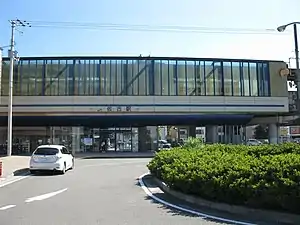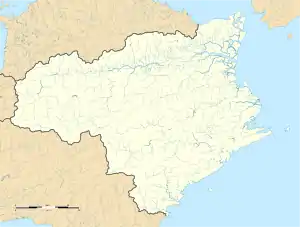T01 B01 Sako Station 佐古駅 | |||||||||||||||||||||||||
|---|---|---|---|---|---|---|---|---|---|---|---|---|---|---|---|---|---|---|---|---|---|---|---|---|---|
 Sako Station Entrance in 2010 | |||||||||||||||||||||||||
| General information | |||||||||||||||||||||||||
| Location | 19 Sako Nibanchō, Tokushima City, Tokushima Prefecture 770-0022 Japan | ||||||||||||||||||||||||
| Coordinates | 34°04′49″N 134°32′18″E / 34.0802°N 134.5383°E | ||||||||||||||||||||||||
| Operated by | |||||||||||||||||||||||||
| Line(s) | |||||||||||||||||||||||||
| Distance | |||||||||||||||||||||||||
| Platforms | 1 island platform | ||||||||||||||||||||||||
| Tracks | 2 | ||||||||||||||||||||||||
| Construction | |||||||||||||||||||||||||
| Structure type | Elevated | ||||||||||||||||||||||||
| Bicycle facilities | Bike parking under elevated structure | ||||||||||||||||||||||||
| Accessible | Yes - elevators to platform | ||||||||||||||||||||||||
| Other information | |||||||||||||||||||||||||
| Status | Staffed - JR ticket window | ||||||||||||||||||||||||
| Station code | B01, T01 | ||||||||||||||||||||||||
| History | |||||||||||||||||||||||||
| Opened | 20 March 1935 | ||||||||||||||||||||||||
| Passengers | |||||||||||||||||||||||||
| FY2019 | 856 | ||||||||||||||||||||||||
| Services | |||||||||||||||||||||||||
| |||||||||||||||||||||||||
| Location | |||||||||||||||||||||||||
 Sako Station Location within Tokushima Prefecture  Sako Station Sako Station (Japan) | |||||||||||||||||||||||||
Sako Station (佐古駅, Sako-eki) is a junction passenger railway station located in the city of Tokushima, Tokushima Prefecture, Japan. It is operated by JR Shikoku and has two station numbers: "B01" for the Tokushima Line and "T01" for the Kōtoku Line.[1][2]
Lines
Sako Station is served by both the Tokushima Line and the Kōtoku Line. On the Tokushima Line, the station is considered the official terminus and is located 67.5 km from the opposing terminus at Tsukuda. Both the local and limited express services of the Tokushima Line run on to Tokushima but this latter station is not considered part of the line and it does not bear a station number with the "B" prefix.
On the Kōtoku Line, the station is 73.1 km from the beginning of the line at Takamatsu.
Only trains from the local services of the Tokushima and Kōtoku Lines stop at Sako. In addition, although Ikenotani is the official start point of the Naruto Line, many of the trains of its local service begin and end at Tokushima. These trains also stop at Sako.[3]
Layout
The station consists of an island platform serving 2 elevated tracks. A waiting area, kiosk and a JR ticket window (without a Midori no Madoguchi facility) located on the 1st level of the station.[4] Steps and an elevator provide access to the island platform at the second level. Parking for bicycles is available under the elevated tracks.[2][5][6]
Platforms
| 1 | B Tokushima Line | for Anabuki and Awa-Ikeda for Tokushima and Anan |
| 2 | T Kōtoku Line (Naruto Line) | for Tokushima and Anan for Itano, Takamatsu and Naruto |
 A view of the island platform looking in the direction of Yoshinari.
A view of the island platform looking in the direction of Yoshinari.
History
The station was opened Japanese Government Railways (JGR) on 20 March 1935 as an added station on the existing Tokushima Line (later the Tokushima Main Line). With the privatization of Japanese National Railways (JNR), the successor of JGR, on 1 April 1987, the station came under the control of JR Shikoku. On 1 June 1988, the line was renamed the Tokushima Line and Sako was designated as the official terminus.[7][8]
Passenger statistics
In fiscal 2019, the station was used by an average of 856 passengers daily[9]
Surrounding area
- JR Shikoku Bus Tokushima Branch
- Tokushima City Athletics Stadium
See also
References
- ↑ "Shikoku Railway Route Map" (PDF). JR Shikoku. Retrieved 23 December 2017.
- 1 2 "佐古" [Sako]. hacchi-no-he.net. Retrieved 1 February 2018.
- ↑ "Sako Station Timetable" (PDF). JR Shikoku. Retrieved 1 February 2018.
- ↑ "JR四国の駅 窓口営業時間一覧" [JR Shikoku station ticket window opening hours list] (PDF). JR Shikoku. 28 November 2017. Retrieved 1 February 2018.
- ↑ "佐古駅" [Sako Station]. shikoku.org.uk. Retrieved 1 February 2018.
- ↑ Kawashima, Ryōzō (2013). 図説: 日本の鉄道 四国・九州ライン 全線・全駅・全配線・第1巻 四国東部エリア [Japan Railways Illustrated. Shikoku and Kyushu. All lines, all stations, all track layouts. Volume 1 Eastern Shikoku] (in Japanese). Kodansha. pp. 37, 69, 84. ISBN 9784062951609.
- ↑ Ishino, Tetsu; et al., eds. (1998). 停車場変遷大事典 国鉄・JR編 [Station Transition Directory – JNR/JR] (in Japanese). Vol. II. Tokyo: JTB Corporation. pp. 651, 654. ISBN 4-533-02980-9.
- ↑ Ishino, Tetsu; et al., eds. (1998). 停車場変遷大事典 国鉄・JR編 [Station Transition Directory – JNR/JR] (in Japanese). Vol. I. Tokyo: JTB Corporation. pp. 215–216. ISBN 4-533-02980-9.
- ↑ 令和3年版 徳島市統計年報 [Reiwa 3rd Year Edition Tokushima City Statistics Annual Report] (in Japanese). Japan: Tokushima city. 2021. Retrieved 4 July 2022.